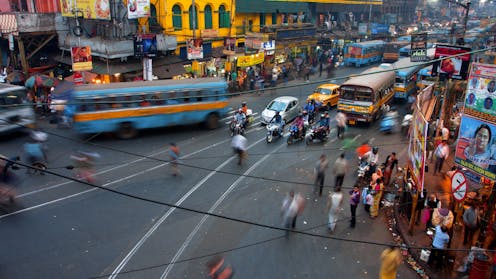UK’s India trade deal offers wider access to a surging economy – and could make food imports cheaper
- Written by Sangeeta Khorana, Professor of International Trade Policy, Aston University

After more than three years and 14 rounds of negotiations, the UK and India have finally announced a free trade agreement (FTA). UK Prime Minister Keir Starmer will formally sign the deal on a visit to India later this year. This is the biggest and most economically significant bilateral trade deal the UK has struck since leaving the EU. It will have implications for both businesses and workers.
In 2024, the UK’s trade with India was worth £43 billion[1] – £17.1 billion of exports and £25.5 billion of imports. Government modelling estimates that trade between the nations will increase by as much as 39%[2] and the UK’s GDP will expand by £4.8 billion[3] or 0.1 percentage points per year as a result.
India’s economy is growing fast. It is expected to expand by 6% annually[4], becoming the world’s third largest economy[5] by 2028 after the US and China. This certainly makes the deal with the UK very timely.
With a population of more than 1.4 billion and a growing middle class, the country offers huge market potential. Its import demand is predicted to grow by 144%[6] between 2021 and 2035. This combination of strong economic growth and increasing numbers of citizens with disposable cash makes a compelling case for the deal.
Tariffs on luxury cars will also be reduced from more than 100% to 10% under quotas on both sides. The FTA locks in zero tariffs on industrial machinery, advanced materials for use in hi-tech industries, and components for electric vehicles. This will position British suppliers inside a manufacturing market ranked the world’s second-most attractive[12] after China.
In terms of workers, there were well publicised fears[13] that the agreement might lead to UK workers being undercut by Indian counterparts. Plans for a so-called “double contribution convention”[14] grants a three-year exemption from national insurance contributions for Indian employees temporarily working in the UK. But this is a reciprocal deal and is likely to apply only to workers who are seconded from one country to the other, so should not result in UK workers being more expensive to hire.
And although no changes to immigration policy are planned, the FTA will offer easier movement for skilled workers. UK providers of services like construction and telecoms will have access to India’s growing market.
Both countries have committed to encouraging the recognition of professional qualifications. A professional services working group for UK and Indian government officials will provide a forum to monitor and support this initiative.
Against a backdrop of rising protectionism and geopolitical tensions, the UK-India FTA stands out as a strategic deal. It is also a significant milestone in Britain’s Indo-Pacific “tilt”. This approach gives UK firms a hedge against over-reliance on any single region or country-centric supply chains, to keep trade flowing in the event of more US tariff shocks, for example.
With the US fixation on tariffs, and global supply chains facing continued disruption, securing preferential access to the world’s fastest-growing major economy[15] is a strategic win for the UK. From India’s perspective, the trade deal is aligned with its rise as a “China-plus-one”[16] manufacturing hub (where businesses diversify to ensure they do not invest only in China).
The UK and India share historical ties that are underpinned by cultural, educational and people-to-people links. The UK-India FTA marks a new phase in this relationship, where shared economic interests define a forward-looking partnership between the two countries.
And in terms of its ongoing talks[17] with the EU, India could use the agreement to showcase its willingness to negotiate ambitious trade deals. For the UK, given its own upcoming trade and cooperation talks[18] with the EU, the FTA with India demonstrates that new partnerships can be built while maintaining vital European ties.
References
- ^ £43 billion (assets.publishing.service.gov.uk)
- ^ as much as 39% (www.gov.uk)
- ^ expand by £4.8 billion (www.gov.uk)
- ^ 6% annually (economy-finance.ec.europa.eu)
- ^ third largest economy (timesofindia.indiatimes.com)
- ^ grow by 144% (www.gov.uk)
- ^ Sign up to our daily newsletter (theconversation.com)
- ^ Join The Conversation for free today (theconversation.com)
- ^ up to a year (www.bbc.com)
- ^ 12% and 16% (www.gov.uk)
- ^ Yevhen Prozhyrko/Shutterstock (www.shutterstock.com)
- ^ second-most attractive (indianexpress.com)
- ^ well publicised fears (www.bbc.com)
- ^ “double contribution convention” (www.gov.uk)
- ^ fastest-growing major economy (www.worldbank.org)
- ^ “China-plus-one” (www.business-standard.com)
- ^ its ongoing talks (indianexpress.com)
- ^ trade and cooperation talks (www.theguardian.com)







